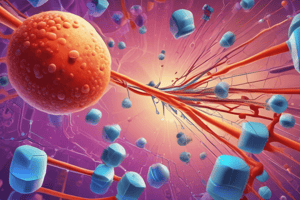Podcast
Questions and Answers
What is the primary aim of adding targeting moieties to block copolymers in drug delivery systems?
What is the primary aim of adding targeting moieties to block copolymers in drug delivery systems?
- To inhibit receptor-mediated targeting
- To enhance receptor-mediated targeting (correct)
- To promote systemic drug distribution
- To enhance passive diffusion of drugs
Which type of polymer is commonly used in solid polymeric nanoparticles for drug delivery?
Which type of polymer is commonly used in solid polymeric nanoparticles for drug delivery?
- Heavy metal polymers
- High molecular weight polymers
- Only natural polymers
- Synthetic biodegradable polymers (correct)
How do PEG-PLGA copolymers function to enhance drug delivery?
How do PEG-PLGA copolymers function to enhance drug delivery?
- By acting as 'stealth' nanoparticles to prolong circulation time (correct)
- By enhancing drug toxicity
- By reducing drug absorption rates
- By increasing the release rate of drugs
What is a key characteristic of the micelles used for delivering Paclitaxel?
What is a key characteristic of the micelles used for delivering Paclitaxel?
What is the main advantage of using NC-6004 for Cisplatin delivery?
What is the main advantage of using NC-6004 for Cisplatin delivery?
What is the role of hydrophilic PEG in the formulation of NC-6004?
What is the role of hydrophilic PEG in the formulation of NC-6004?
Which process do PLGA copolymers undergo inside the body after administration?
Which process do PLGA copolymers undergo inside the body after administration?
What does the term 'EPR effect' refer to in passive targeting of drug delivery systems?
What does the term 'EPR effect' refer to in passive targeting of drug delivery systems?
Which type of dendrimers are known for being hydrophilic and biocompatible?
Which type of dendrimers are known for being hydrophilic and biocompatible?
What characterizes the primary amine terminal groups in poly-lysine dendrimers?
What characterizes the primary amine terminal groups in poly-lysine dendrimers?
How can hydrophobic drugs be incorporated into the structure of dendrimers?
How can hydrophobic drugs be incorporated into the structure of dendrimers?
What is the range of sizes for polymeric micelles?
What is the range of sizes for polymeric micelles?
Which polymer is primarily used for the hydrophilic component of polymeric micelles?
Which polymer is primarily used for the hydrophilic component of polymeric micelles?
What property do polymeric micelles possess that enhances their stability compared to surfactant micelles?
What property do polymeric micelles possess that enhances their stability compared to surfactant micelles?
What is the nature of the polymer chain in polymeric micelles?
What is the nature of the polymer chain in polymeric micelles?
What mechanism can enhance passive targeting in polymeric micelles?
What mechanism can enhance passive targeting in polymeric micelles?
What is the defining architectural feature of dendrimers?
What is the defining architectural feature of dendrimers?
In dendrimers, what do the branching units represent?
In dendrimers, what do the branching units represent?
What is the typical size range of dendrimers?
What is the typical size range of dendrimers?
Which of the following systems is NOT considered a colloidal/nano-carrier system?
Which of the following systems is NOT considered a colloidal/nano-carrier system?
Dendrimers can be designed for which type of targeting?
Dendrimers can be designed for which type of targeting?
What is a key characteristic of lipid-based nano-carrier systems?
What is a key characteristic of lipid-based nano-carrier systems?
Which functional group can be included in dendrimers to modify solubility?
Which functional group can be included in dendrimers to modify solubility?
Which of the following statements regarding the core of dendrimers is true?
Which of the following statements regarding the core of dendrimers is true?
Flashcards
PAMAM dendrimer
PAMAM dendrimer
A type of dendrimer with hydrophilic, biocompatible, and non-immunogenic properties, making them suitable for biomedical applications.
PPI dendrimer
PPI dendrimer
A type of dendrimer containing alkyl and tertiary amine groups, contributing to their structural and chemical characteristics.
PLL dendrimer
PLL dendrimer
A type of dendrimer with positively charged primary amine terminal groups, making them potentially useful for drug delivery.
Polymeric micelles
Polymeric micelles
Signup and view all the flashcards
PEG (Polyethylene glycol)
PEG (Polyethylene glycol)
Signup and view all the flashcards
Polyaspartate, polylactide, or polycaprolactone
Polyaspartate, polylactide, or polycaprolactone
Signup and view all the flashcards
Site-directed drug targeting
Site-directed drug targeting
Signup and view all the flashcards
Colloidal/Nano-carrier Systems
Colloidal/Nano-carrier Systems
Signup and view all the flashcards
What are dendrimers?
What are dendrimers?
Signup and view all the flashcards
Where does the name 'dendrimer' come from?
Where does the name 'dendrimer' come from?
Signup and view all the flashcards
How are the branching units of dendrimers described?
How are the branching units of dendrimers described?
Signup and view all the flashcards
What is the size range of dendrimers?
What is the size range of dendrimers?
Signup and view all the flashcards
What are the main components of a dendrimer?
What are the main components of a dendrimer?
Signup and view all the flashcards
How are dendrimers used for passive targeting?
How are dendrimers used for passive targeting?
Signup and view all the flashcards
How are dendrimers used for active targeting?
How are dendrimers used for active targeting?
Signup and view all the flashcards
Why are dendrimers promising drug delivery systems?
Why are dendrimers promising drug delivery systems?
Signup and view all the flashcards
Targeted Drug Delivery Using Block Copolymers
Targeted Drug Delivery Using Block Copolymers
Signup and view all the flashcards
Solid Polymeric Nanoparticles
Solid Polymeric Nanoparticles
Signup and view all the flashcards
NK105: Paclitaxel-Incorporating Micelles
NK105: Paclitaxel-Incorporating Micelles
Signup and view all the flashcards
NK105 Pharmacokinetics
NK105 Pharmacokinetics
Signup and view all the flashcards
NC-6004: Cisplatin-Incorporating Micelles
NC-6004: Cisplatin-Incorporating Micelles
Signup and view all the flashcards
EPR Effect in Drug Delivery
EPR Effect in Drug Delivery
Signup and view all the flashcards
Stealth Nanoparticles
Stealth Nanoparticles
Signup and view all the flashcards
Study Notes
Advanced Drug Delivery Systems
- Site Directed Drug Targeting (Lecture 4): Focuses on drug carriers for targeted delivery.
Carriers for Drug Targeting
- Soluble macromolecular carrier systems: These systems exist.
- Colloidal/Nano-carrier systems: These systems exist.
- Lipid-based systems: Includes liposomes, solid-lipid nanoparticles, non-emulsions, and others.
- Polymer-based systems:
- Dendrimers: Derived from the Greek word "dendron" meaning "tree". Have a tree-like branched architecture. Their size ranges between 1-100nm. Can include functional groups in 3 parts to modulate solubility, permeability, and thermal stability. Design can include passive targeting with PEG coats and active targeting with ligands like folic acid. Dendrimers under preclinical studies are made of:
- Polyamidoamine (PAMAM) dendrimers: Hydrophilic, biocompatible, and non-immunogenic.
- Poly-propyleneimine (PPI) dendrimers: Contain alkyl and tertiary amine groups.
- Poly-L-lysine (PLL) dendrimers: Have positively charged primary amine terminal groups.
- Polymeric micelles: Nano-sized particles made of polymer chains. Formed by self-assembly in liquid through hydrophobic or ion pair interactions between polymer segments. Each chain is amphiphilic (hydrophobic core and hydrophilic outer segment). Size is 5nm to 100nm and they have narrow particle distribution. Hydrophilic components (mainly PEG) form the outer shell and provide stealth character for passive targeting. Hydrophobic component includes Polyaspartate, polylactide, or polycaprolactone. More stable and have low critical micellar concentrations compared to surfactant micelles. Targeting groups can be added to the surface. Drug solubilised within the core.
- Dendrimers: Derived from the Greek word "dendron" meaning "tree". Have a tree-like branched architecture. Their size ranges between 1-100nm. Can include functional groups in 3 parts to modulate solubility, permeability, and thermal stability. Design can include passive targeting with PEG coats and active targeting with ligands like folic acid. Dendrimers under preclinical studies are made of:
- Solid polymeric nanoparticles: Prepared using natural or synthetic polymers. Commonly, biodegradable synthetic polymers such as poly(lactide-co-glycolide) (PLGA), polylactic acid (PLA), and polycaprolactone (PCL) are used. Polysaccharides like chitosan are also used. In the body, copolymers of polylactic and glycolic acid undergo hydrolysis into glycolic and lactic acid, which are removed by the body via the citric acid cycle. Used for passive targeting of drugs to tumour sites via the EPR effect. PEG-PLGA copolymers are used as stealth nanoparticles to prolong circulation time. Active targeting with targeting ligands is also studied.
Formulations of Some Drug Targeting Delivery Systems
- Polymeric micellar formulations:
- Paclitaxel-incorporating micelles (NK105): Contain block copolymers with PEG and polyaspartate. The MW is 20kDa with PEG at 12kDa. Paclitaxel is physically entrapped (23%w/w) in the core via hydrophobic interactions. In animal studies, slower clearance from the plasma with increased half-life (5x longer) was seen, along with a 2-3 fold increase in PTX concentration at the tumour site.
- Cisplatin-incorporating micelles (NC-6004): Contains PEG-poly(sodium-L-glutamate) block copolymer. PEG forms the outer hydrophilic shell. The hydrophobic core contains cisplatin complexed with the PGA component. Overall MW is 18kDa with 12kDa PEG contribution. Size is 30nm. Improved circulation time and tumour targeting, reducing side effects.
Stimuli-Responsive Nano-carrier Systems (Smart DDS)
- Ideal Drug Delivery Systems: Release the required amount of drug at the target site. Efficient drug release strategies are needed for targeted cells, tissues, or organs, such as on-demand processes (on/off switching) providing tailored release profiles. On-demand drug-delivery is possible through design of stimulus-responsive systems.
- Internal stimuli: Triggered drug release from systems based on pH changes, enzymes, redox potential, and solute concentrations. pH responsive systems, for example take advantage of pH variations existing across organs.
- External stimuli: Triggered drug release from systems based on temperature change, magnetic fields, ultrasound, and electric fields.
- Thermoresponsive systems: Retain drug load at body temperature (~37°C) and rapidly release it at target site (~40-42°C). Systems include liposomes, polymer micelles, or nanoparticles.
- Magnetically responsive systems: Magnetic guidance and drug release under permanent magnetic fields can occur; temperature increase in an alternating magnetic field; magnetic resonance imaging (MRI) development for associated therapy and diagnostics. Examples include core-shell nanoparticles made of magnetite (Fe3O4) coated with silica or polymer, or magnetoliposomes with Fe3O4 nanocrystals encapsulated within liposomes. Continuous magnetic fields can trigger drug delivery in ferrogel systems made of Pluronic F127 micelles encapsulating super magnetic iron oxide nanoparticles. Alternating magnetic fields increase heat and may lead to hyperthermia for tumour treatment.
- Examples/details (Liposomes): Conventional and PEGylated liposomes. These can be adapted for theranostic or ligand-targeted uses to provide advanced drug delivery.
Studying That Suits You
Use AI to generate personalized quizzes and flashcards to suit your learning preferences.




